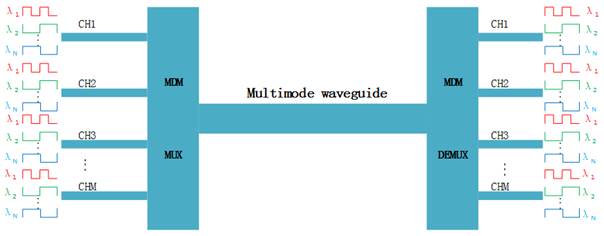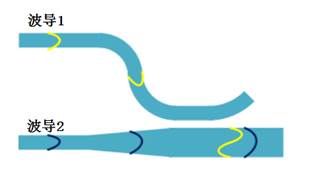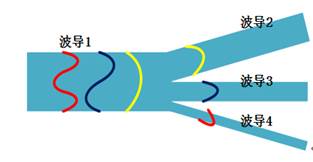| |
|
A large number of studies on multimode fiber and multicore fiber in recent years have revealed that space division multiplexing can further improve the communication capacity and spectrum utilization efficiency of a single fiber. As shown in Figure 1, as a physical dimension that can carry information, on the one hand, mode can be further improved by wavelength multiplexing to further increase the number of channels. On the other hand, the number of required lasers can be reduced while maintaining the number of channels. Due to the absolute advantages of silicon-based photonic devices in terms of cost and integration, it is of great significance to carry out research on silicon-based modular multiplexer devices and systems.
|
|

Figure 1: System with N wavelengths and M modes simultaneously multiplexed
|
|
The core of the DIP system is a mode-based multiplexing/demultiplexing device. The currently implemented methods mainly include asymmetric directional couplers and asymmetric branch structures.
The mode multiplexing, taking the multiplexing of the fundamental mode and the first-order mode as example, its structure of the asymmetric directional coupler is shown in the left of FIG. 2, the waveguide 1 is a single-mode waveguide, and the wide waveguide portion of the waveguide 2 supports the fundamental mode and the first-order mode. According to the coupled mode theory, when the effective refractive index of the fundamental mode in the waveguide 1 and the effective refractive index of the first-order mode in the waveguide 2 are equal, the phase matching condition is satisfied, the 1 fundamental mode in the waveguide 1 and the first-order mode in the waveguide 2 mutual coupling occurs, and after a certain distance, the fundamental modes in the waveguide 1 are all coupled into the waveguide 2 and converted into a first-order mode; the fundamental mode input from the waveguide 2 maintains the fundamental mode state through the adiabatic taper to the wide waveguide, due to the difference in effective refractive index between the fundamental mode of the waveguide 2 and the fundamental mode of the waveguide 1 does not occur between the two. In summary, the asymmetric directional coupler structure completes the multiplexing process of the fundamental mode and the first-order mode. Multiple modes of multiplexing can be achieved by cascading multiple similar asymmetric directional coupler structures.
|
|
 
Figure 2: Asymmetric directional coupler and asymmetric multi-branch structure
|
|
Taking three modes of demultiplexing as an example, its asymmetric branch structure is shown in the right of Figure 2. The waveguide 1 supports three modes: fundamental mode, first-order mode, and second-order mode. Waveguide 2, waveguide 3, and waveguide. 4 only support the fundamental mode, and the sum of their widths is equal to the width of the waveguide 1. The angle between them should be sufficiently small. This branching structure has the characteristic that the pattern in the waveguide 1 is converted into the fundamental mode in the waveguide 2, waveguide 3 or the waveguide 4 whose effective refractive index is closest. The effective refractive index relationship of the three modes in the waveguide 1 is: fundamental mode > first-order mode > second-order mode, and the effective refractive index relationship of the fundamental modes in the waveguides 2, 3, 4 is: waveguide 2 fundamental mode > waveguide 3 fundamental mode >Waveguide 4 fundamental mode, through the optimization of the device structure, the fundamental mode in the waveguide 1 can be converted into the fundamental mode in the waveguide 2, the first-order mode in the waveguide 1 is converted into the fundamental mode in the waveguide 3, and the second in the waveguide 1 The mode is converted into a fundamental mode in the waveguide 4, thereby completing the demultiplexing of the three modes.
Cornell University, Columbia University, Brookhaven National Laboratory, Carleton University of Canada, Institute of Semiconductors of Chinese Academy of Sciences, Zhejiang University, and Huazhong University of Science and Technology, etc., all on-chip modular multiplex/demultiplex devices Research. Representative research results include simultaneous multiplexing/demultiplexing of 3 modes x 3 wavelengths [1], simultaneous multiplexing/demultiplexing of 4 modes x 2 polarization states [2], etc.
。
This research group has a certain research basis for silicon-based modular multiplex/demultiplexer devices, and is currently undergoing in-depth research.
|
|
[1] L.-W. Luo, N. Ophir, C. Chen, L. H. Gabrielli, C. B. Poitras, K. Bergman, et al., "Simultaneous mode and wavelength division multiplexing on-chip," arXiv preprint arXiv:1306.2378, 2013.
[2] J. Wang, S. He, and D. Dai, "On‐chip silicon 8‐channel hybrid (de) multiplexer enabling simultaneous mode‐and polarization‐division‐multiplexing," Laser & Photonics Reviews, vol. 8, pp. L18-L22, 2014.
|
|

